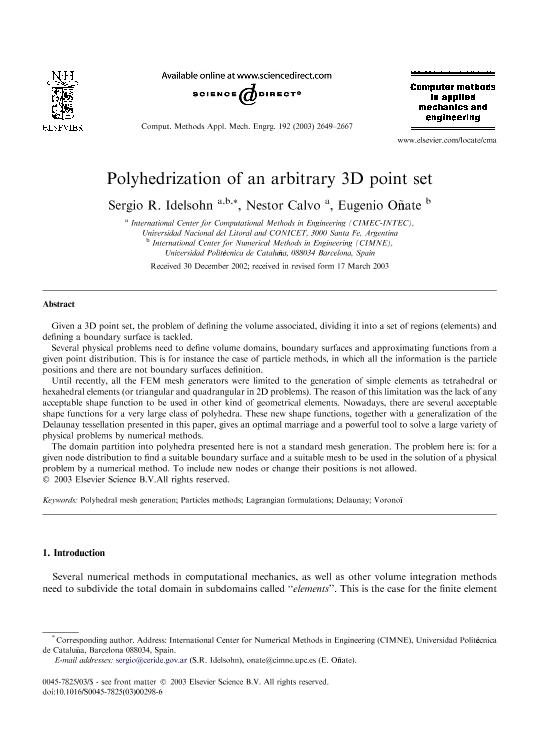Artículo
Polyhedrization of an arbitrary 3D point set
Fecha de publicación:
12/2003
Editorial:
Elsevier Science Sa
Revista:
Computer Methods in Applied Mechanics and Engineering
ISSN:
0045-7825
Idioma:
Inglés
Tipo de recurso:
Artículo publicado
Clasificación temática:
Resumen
The extended Delaunay tessellation (EDT) is presented in this paper as the unique partition of a node set into polyhedral regions defined by nodes lying on the nearby Voronoï spheres. Until recently, all the FEM mesh generators were limited to the generation of tetrahedral or hexahedral elements (or triangular and quadrangular in 2D problems). The reason for this limitation was the lack of any acceptable shape function to be used in other kind of geometrical elements. Nowadays, there are several acceptable shape functions for a very large class of polyhedra. These new shape functions, together with the EDT, gives an optimal combination and a powerful tool to solve a large variety of physical problems by numerical methods. The domain partition into polyhedra presented here does not introduce any new node nor change any node position. This makes this process suitable for Lagrangian problems and meshless methods in which only the connectivity information is used and there is no need for any expensive smoothing process.Given a 3D point set, the problem of defining the volume associated, dividing it into a set of regions (elements) and defining a boundary surface is tackled.
Several physical problems need to define volume domains, boundary surfaces and approximating functions from a given point distribution. This is for instance the case of particle methods, in which all the information is the particle positions and there are not boundary surfaces definition.
Until recently, all the FEM mesh generators were limited to the generation of simple elements as tetrahedral or hexahedral elements (or triangular and quadrangular in 2D problems). The reason of this limitation was the lack of any acceptable shape function to be used in other kind of geometrical elements. Nowadays, there are several acceptable shape functions for a very large class of polyhedra. These new shape functions, together with a generalization of the Delaunay tessellation presented in this paper, gives an optimal marriage and a powerful tool to solve a large variety of physical problems by numerical methods.
The domain partition into polyhedra presented here is not a standard mesh generation. The problem here is: for a given node distribution to find a suitable boundary surface and a suitable mesh to be used in the solution of a physical problem by a numerical method. To include new nodes or change their positions is not allowed.
Archivos asociados
Licencia
Identificadores
Colecciones
Articulos(INTEC)
Articulos de INST.DE DES.TECNOL.PARA LA IND.QUIMICA (I)
Articulos de INST.DE DES.TECNOL.PARA LA IND.QUIMICA (I)
Citación
Idelsohn, Sergio Rodolfo; Calvo, Nestor Alberto; Oñate, Eugenio; Polyhedrization of an arbitrary 3D point set; Elsevier Science Sa; Computer Methods in Applied Mechanics and Engineering; 192; 12-2003; 2649-2667
Compartir
Altmétricas




